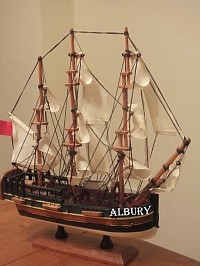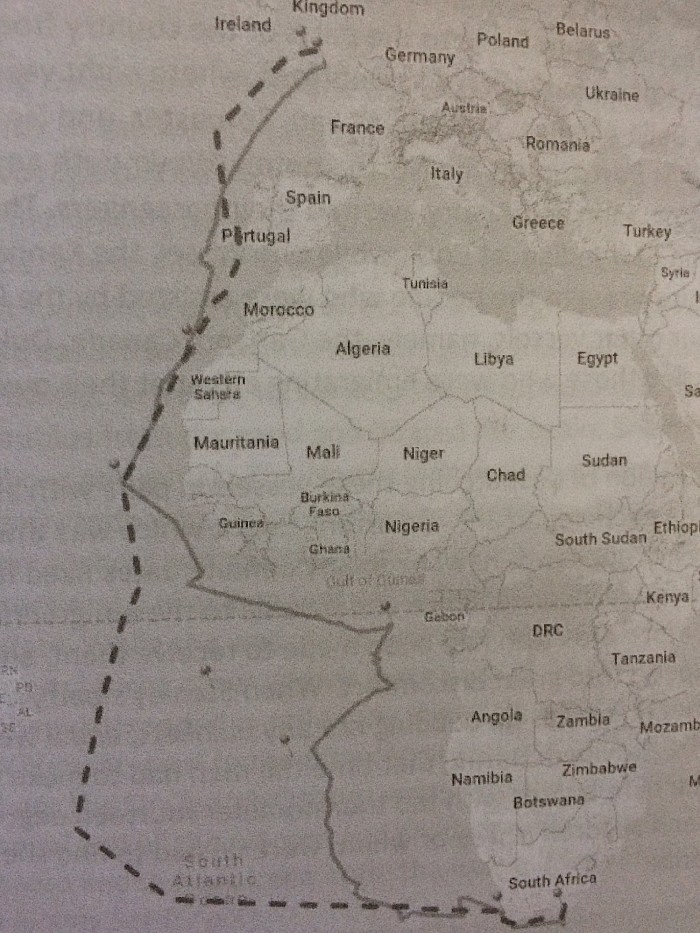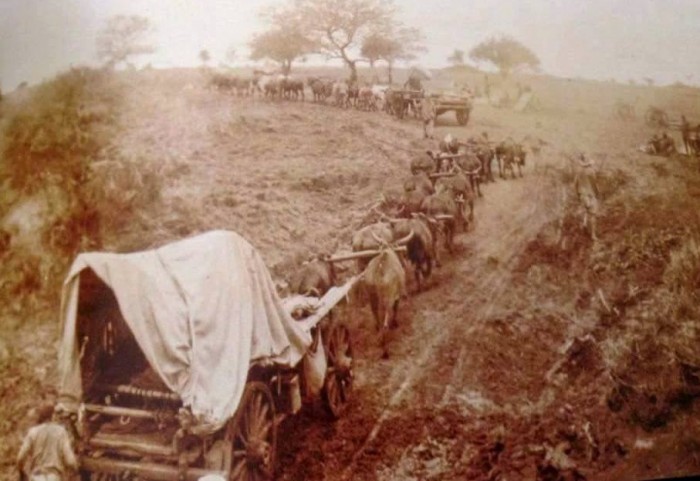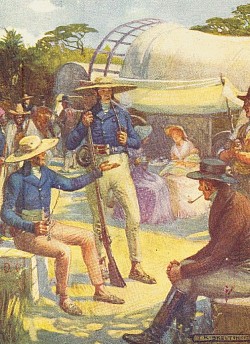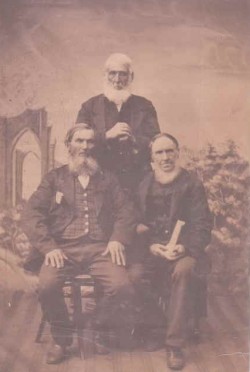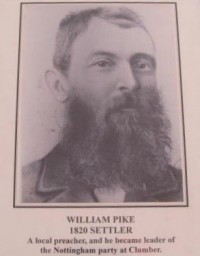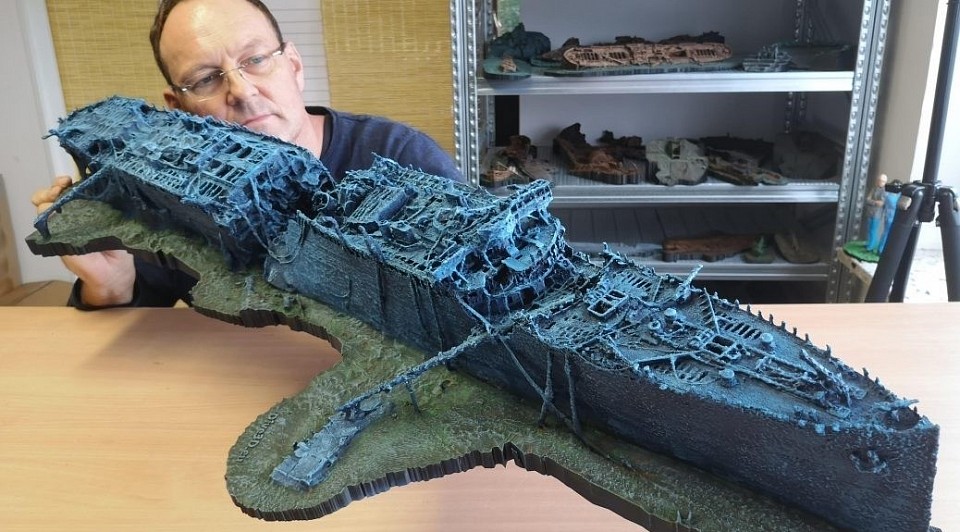THE JOURNEY OF THE NOTTINGHAM PARTY FROM NOTTINGHAM, ENGLAND, TO CLUMBER IN THE CAPE COLONY
LEAVING HOME - THE JOURNEY FROM NOTTINGHAM, ENGLAND, TO ALGOA BAY IN THE CAPE COLONY
The Nottingham party comprised of 164 persons ; 58 men, 27 women and 79 children. This of a total of 3800 people who emigrated from Great Britain. This group had to travel from Nottingham to Liverpool, a distance of some 170 km to join the vessel Albury there. The organizing committee had to arrange transport , have boxes made for personal possessions as well as goods supplied by the committee such as children's clothes and writing instruments. Whilst deciding how to transfer this group of people from Nottingham to Liverpool the possibility of using Fly canal boats was also investigated. This option was however rejected and it was decided to move them by road. From correspondence we know that the Nottingham Party commenced boarding the vessel Albury, 330 tons, in Liverpool, by mid January 1820, leaving the central point of departure, Nottingham, in early January. The weather must have been bitterly cold as further South in London, ships on the River Thames were stuck in the ice and unable to sail. Some of these ships carrying Settler Parties were affected and with all passengers aboard, departure was delayed until the ice melted.
The men of the Nottingham Party left Nottingham on 10 January 1820 and walked over the Pennine Moors under Sergeant George Dennison, accompanying the wagons carting the 16 tons 7cwt of provisions and personal possessions (including 2 ploughs and 2 harrows). This journey on foot involved being 3 nights on the road before they reached Liverpool.The wagons were supplied by Mr R Hillberson of Chapel-en-le-Frith in Derbyshire at a cost of £114.18s.7d. The women and children journeyed by coaches, hired from Mr Simpson of Nottingham for £37.6s.0d, traveling 13 persons per coach, 4 inside and 9 outside. They journeyed via Leek and Macclesfield to avoid the Derbyshire hills so that the journey could be completed in a day. The first coach left Nottingham on 12 January and the last on 21 January. Young Elijah Pike recalls the four in hand coach his family travelled in from Nottingham and was in wonder at the forest of masts and spars he saw in the dock at Liverpool. Thomas Calton, the leader of the Nottingham Party, and his family, stayed at Saracen's Head Hotel in Dale Street in Liverpool, prior to embarking on the vessel Albury, the ship which was to convey the Nottingham Party to the Cape Colony. A receipt dated 12 January shows that a Mr Sharples billed him for tea, coffee, rum, gin, ale, paper, pens, fires, in addition to his bed and sitting rooms hire. The settlers, however, had rooms at 19d per night at the local grocer, William Whittaker, whose premises was situated at 2 Xbow Lane. Not only did he supply rooms but also vegetables, herbs, sugar, bread, dripping, butter, tea, ale, milk, mustard, beef steaks and flour. This accommodation was necessary as the Albury was not docked, but was lying anchored in the River Mersey. Access to the vessel had to be by prior arrangement and was by small craft. Boarding the vessel was done in stages as the list of proposed settlers was in a constant state of flux. A letter from 19 November 1819 from the Duke of Newcastle to Godfrey urges him to "have as compleat and efficient list made out". Now, in January 1820 the list was still under scrutiny by Calton who rejected some, with reasons given as " naturally sickly, character bad, idle " and others were still coming forward to be added to the list. As late as 16 January the list was far from finalised , Calton taking 30 people on board the Albury on this date and half were returned owing to their names not being on the list. By 20 January 112 settlers had boarded and 31 were on shore. Calton and his family finally boarded on 27 January after goods which were impounded were finally released the day before. There was also confusion over payment to Hilberson for the use of the wagons conveying the goods from Nottingham. This payment should have been effected in Nottingham but wasn't, so the goods were impounded. The 2 wagons arrived on January 13 (and presumably the men of the party) and the goods were only released on 26 January after the transport payment was resolved. It must have been a relief to finally gain access to their personal belongings after such a long delay. The Albury was anchored on the River Mersey when on Friday 28 January 1820 the Liverpool Auxiliary Bible Society came aboard to ascertain if Bibles were needed by the emigrants. After ascertaining that all could read, the Depositary came aboard again on Monday 31 January to distribute Bibles. Henry Holland, aged 22, a stone mason, penned a letter of thanks to the Society. Liverpool was a Centre of embarkation at this time as there were two other vessels, namely Stentor and John, which were embarking Parties whose destination was the same as the Albury, the Cape of Good Hope. Stentor and John sailed on the same day, 13 January 1820, leaving the Albury still anchored in the river. Due to a cold front sweeping in from the direction of Ireland, the Albury only sailed on 13 February 1820.
The Albury log dated 13 February 1820 records the deaths of Susannah Hartley, 6 months, daughter of Thomas and Sarah Hartley, and John Cross, infant son of John and Mary Cross. These deaths, according to George Dennison in a letter to E S Godfrey " have been occasioned by being so long on this unhealthy river".
Until 18 February there were heavy seas caused by gales off the coast of Wales. The weather was so bad that the hatches had to be battened down, causing alarm to the passengers as they were now not only confined, but effectively locked in, to below deck. In the uproar that ensued they accused the Captain of being incompetent.
27 February 1820 Anchored at Madeira
1 March 1820 Passed the Canary Islands
3 March 1820 Came aside the Aquatic laden with coal for St Helena
5 March 1820 Passed a Portuguese slave ship
9 March 1820 John Sykes complained of being ill. He took a purgative and some spirits
12 March John Sykes still very ill and took Calomel
13 March 1820 Caught a shark
14 March 1820 Came alongside the Charles Grant and another ship. Longitude 22. Day Temperature 84 deg F, Night Temperature 82 deg F Thomas Calton in a letter on this date wrote : " some there are whom I find have proved themselves greater eaters than workers, so I am afraid will prove the same at the Cape. These are the Frame Work Knitters. I must sincerely beg and pray you to send no more here"
He also adds that the Settlers are lying 4 to 6 in a bed and even that there are two men with their wives in the same bed, notes : " I wonder no mistakes are made"
15 March 1820 Crossed the Equator. John Sykes' health continues to deteriorate and has broken out in an eruption from head to toe.
18 March 1820 Met up with Clydesdale merchant ship Bengal heading to Bengal
19 March 1820 Sykes very ill
20 March 1820 John Sykes died at midnight
21 March 1820 The captain went aboard Nestex on her way from Calcutta to England
27 March 1820 Got the trade winds after being virtually becalmed since the 10th March
4 April 1820 Crossed the tropics with a moderate breeze
8 April 1820 Gales and heavy winds continued till 17 April 17 April 1820 One man shot a large bird
18 April 1820 Light breeze, three albatrosses shot, one with a 5 ft 9 inch wingspan
1 May 1820 Came in sight of the Cape and at midnight anchored in Simon's Bay
To their dismay the Nottingham Party was not allowed to go ashore at Simon's Bay but had to wait on board before they could commence the final leg of their journey to Algoa Bay.
The vessel Albury was built in 1804 and classified as a ship with Mr Cunningham as Captain. It had a single deck with beams and the boards were sheathed with copper. The Albury was 96 feet long and had a beam, or width, of 24 feet. The depth was 17ft 6 in .As a comparison, a tennis court is 78 feet long and 36 feet wide. To compare square footage the Albury was 2304 and a tennis court 2808 - so the Albury deck was smaller than a tennis court by some 504 square feet! This gives some idea of the limited space 164 persons had to occupy for so long. Accommodation was apparently rather cramped and confining as one could not walk upright below deck. The single men were given a blanket and had to find a place to sleep on the bare boards. In some instances the married folk were even lying 4, and some instances, 6, to a bed ! Afraid of the spread of disease aboard, Elijah Pike recalled how he and many other children were continually washed by their respective mothers as a disease preventative when one of the children died on the journey. The Settlers traveling on the Vessel Zoroaster had to transfer to the Albury at Simons Town and joined the Nottingham Party for the final leg to Algoa Bay. The Zoroaster carried 142 persons; C Dyason's Party from London numbering 67, W Wait's Party numbering 40 from Middlesex and C Thornhills Party numbering 35. The Albury accommodation was already cramped and with an additional 142 persons joining, making a total of 306 persons, conditions could not have been pleasant. Jeremiah Goldswain of the Wait Party had this to say about the Albury : ""we got on board to see the difference between the two ships. I was astonished; the Zoroaster was as clean as possible for a Vessel to be, but the Albury you could not walk upright between her decks and she was not the cleanest Vessel I ever saw."
LAST DAYS ABOARD PRIOR TO DISEMBARKING
On 15 May 1820 The Albury finally arrived at Algoa Bay but due to congestion and heavy seas her passengers could not disembark. On this date not only did the Albury arrive but 3 other ships also anchored off Algoa Bay; the Aurora carrying 344 Settlers, the Brilliant carrying 144 Settlers and the Weymouth carrying 478 Settlers.
There was no pier or infrastructure at Algoa Bay. All Vessels had to ride at anchor and await their turn, in strict rotation according to arrival, before instructions were given to disembark.
The Albury passengers had to wait on board for almost two weeks before they could disembark. They finally stepped ashore on 28 May 1820, having spent a total of 131 days aboard the Albury from the day we know that some were aboard, which, according to documentation, was 17 January 1820 in Liverpool.( The Nottingham Party did not all board on the same day, this was spread over 10 days)
Settlers were lowered in their vessel's boats and then transferred to flat bottomed surf boats and pulled through the tumbling breakers by ropes from the shore. When they reached shallow water the men got out and had to wade through the surf. The women and children were carried by sailors and soldiers to the beach. Captain Fairfax Moresby of the H.M.S.Menai was the naval officer in charge of arrival and landing of the Settler vessels. Captain Evatt was in charge of transferring the Settlers from the flat bottomed boats to the shore . He was Commandant of Fort Frederick, the stone fort that stood atop the small hill above the landing beach. All credit to these two gentlemen that in their concern for the wellbeing of this vast influx of people, that not one fatality resulted from the landing process.
THE OX WAGON JOURNEY TO THEIR NEW BEGINNINGS
The Journey from Algoa Bay to Clumber
Accommodation for the Settlers was provided in some 2000 tents on the sea shore which the Settlers named Tent Town. The Nottingham Party had to wait here for wagons and carts to transport them to their destination ; some 120 miles distant.. All Settlers were made to wait in strict rotation, as landed, for transport. There were allready 1500 people in the queue ahead of the Nottingham Party. They were still waiting for transport on 8 July 1820 when Thomas Calton , the leader of the party, died. They elected a new leader, Thomas Draper, on 10 July 1820.
The Nottingham Party finally left Tent Town in a convoy of around 30 wagons on 15 July 1820 , a long wait on the sand dunes from when they first set foot on shore on 28 May 1820. . Approximately 3 families shared a wagon, but there was a substantial amount of luggage and goods. Consider the tents which were needed as temporary accommodation, agricultural implements, rations and personal belongings which needed to be taken along. Soon after leaving, one of the wagons tried to cross an old road, lurched, and fell on its side upending its contents and pinning the young Elijah Pike underneath. Fortunately soft sand cushioned the blow and he escaped unhurt. The wagon train travelled North, then East, crossing the Zwartkops and Couga Rivers near the coast. Then inland over Grass Ridge to Addo Drift, across the Sunday's River about 20 miles from the mouth, and then over Addo Heights. Then South East, more or less parallel to the coast, passing Congo's Kraal and Graafwater to Jagers Drift on the Bushman's River. After the Mission Station at Theopolis, they forded the Kowie River at its mouth at low tide by utilizing two exposed sandbanks. Then inland via Kowie Pass to Bathurst and on to their final destination. They outspanned at the foot of a small hill close to the Torrens River on 25 July 1820. There was no infrastructure here, no town, only open uninhabited and unworked land. After offloading their possessions the wagons departed, leaving the Nottingham Party to fend for themselves and to forge a new life.
Young Rosa Pike recalled :
"I remember that while the wagons were being unloaded...I ran down to look at a small river which was near, and on my return found my mother sitting on a large box and crying. On asking her what was the matter, she said she was afraid, she thought the tigers and wolves would come that night and eat us up."
They named the small hill at the base of which they had offloaded their belongings, Mount Mercy. At the top of the hill they held a service of thanksgiving for safe deliverance of a journey that had taken over 6 months.
"It seemed very lonely to us when the wagons went away and left us all alone among the thorns and bushes" said a young Elijah Pike.
The Party originally considered naming their location Mansfield, but decided to name their location Clumber after the seat of the Duke of Newcastle, Clumber Park. This in appreciation for his genuine concern for the welfare of this group of people whose financial situation was dire. Under his chairmanship a public subscription was raised to assist the destitute to emigrate.
Wagon Routes
The Wagon Routes Undertaken by the 1820 Settlers Showing a Northern and Southern Route
The Northern route connected the Grahamstown military outpost with Fort Frederick in Algoa Bay . The Southern , or coastal route, connected Port Alfred with Algoa Bay.
The Nottingham Party followed the Southern route, crossing the Kowie River at Port Alfred and then turning North to Bathurst and reaching their final destination at a place which they named Clumber, a couple of Kilometres from Bathurst.
Crossing the last River, the Kowie, before heading North to Clumber
Fording the Kowie River by ox wagon was no easy task. This map, drawn in 1820, shows the road leading from Theopolis Mission in the West down to the Kowie River and exiting to Bathurst in the East. The spot the Settler Parties' used to cross the river was close to the mouth where two sand banks were exposed at low tide. There are records which show that even at low tide the cattle pulling the wagons had water flowing over their backs as they crossed the channels.
On 26 April 1820 when the very first convoy of wagons from Fort Frederick, numbering 96 ox wagons and some 400 settlers forded the Kowie River, Francis, son of Francis Stanley of Owen’s Party, drowned. So the crossing here must have been extremely hazardous.
LEADERS OF THE NOTTINGHAM PARTY
Is it Calton's Party or Nottingham Party ?
On this Website we refer to the " Nottingham Party".
In the articles on 1820 Settlers it is generally referred to as "Calton's Party", in reference to his leadership of the Party. We refer to it as the "Nottingham Party" as they departed from there and the leadership of the Party was eventually passed to 3 people. Calton, the original leader, died in Algoa Bay on 8 July whilst the Party was awaiting transport. Leadership then passed to Thomas Draper and subsequently and finally to William Pike after Thomas Draper received permission to leave Clumber.

